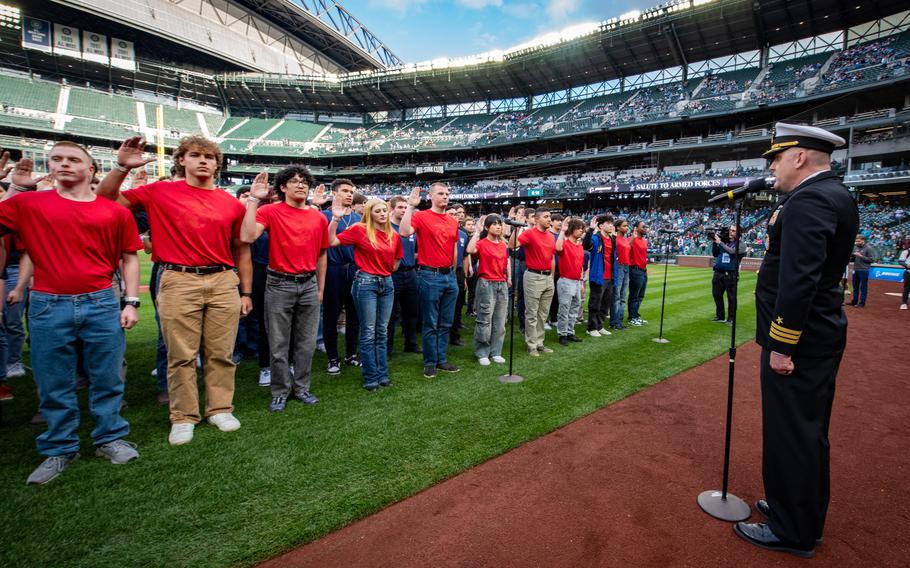
U.S. Navy Cmdr. Richard Jarchow, commanding officer of Navy Talent Acquisition Group Pacific Northwest, administers the oath of enlistment to future service members during a joint-service ceremony at T-Mobile Park during the Seattle Mariners’ Salute to Armed Forces Night in Seattle, Wash., on April 12, 2025. (Torrey W. Lee/U.S. Navy)
Just months into 2025, the data tells a striking story: Military recruitment is back, and it’s booming. Under President Donald Trump’s renewed leadership, the United States armed forces aren’t just meeting their recruitment goals, they’re exceeding them by double digits across the board. After years of a national security crisis, America’s warrior ethos is being revived, and young patriots are answering the call.
The numbers don’t lie. As of February 2025, the Army has already recruited 23,586 new soldiers, an astonishing 115% of its cumulative goal for this period of the fiscal year. The Navy sits at 105%, the Marine Corps at 106%, and both the Air Force and Space Force have hit their targets right on schedule. This isn’t just a statistical rebound, it’s a cultural one. The military is once again a magnet for those who believe in duty, honor and country.
Compare that to the dismal recruiting environment under the previous Biden administration. In 2023, three out of the four major branches failed to hit their targets. A veteran-led survey conducted by YouGov confirmed what many of us already knew: the military’s embrace of divisive diversity, equity and inclusion (DEI) initiatives, coupled with a growing mistrust in political leadership, was driving away the next generation of warriors.
Veterans, who historically have been the most effective ambassadors for military service, have been pulling away. Pew Research once showed that 80% of veterans recommended service to young people. In 2024, that number cratered to just 62%. Among conservative veterans, the military’s most enduring recruitment base, endorsement dropped from 88% to 53% in five years. Why? 85% of those surveyed cited the military’s DEI and social policies as a major deterrent.
DEI may play well in corporate boardrooms or faculty lounges, but not on the battlefield. Americans want to know the military is focused on merit, not identity politics. Instead, service members watched as DEI officers replaced combat readiness as a top priority. They saw promotion systems weighted with race and gender preferences, instead of experience and performance excellence. For years, they heard leadership insist diversity was “essential” to every mission, even as force cohesion eroded and trust in leadership plummeted.
President Trump changed that dynamic. He campaigned on restoring the military’s focus and pride, and his administration wasted no time returning to basics: merit, strength and respect for service. The Trump administration is rebuilding a culture of purpose and competence. No more identity quotas. No more ideological tests. Just the mission, and the people who volunteer to carry it out.
This course correction resonates not just in metrics but in morale. Veterans who felt alienated by an increasingly politicized Pentagon now feel their values reflected in the chain of command, including the commander in chief. The traditional military family is now re-engaged, proud to pass the torch to the next generation.
Let’s be clear: Military recruitment is a barometer of national strength and pride. When enlistment numbers rise, it means Americans believe in their country, their leadership, and the strategic direction they set. The resurgence under President Trump is more than a win for his administration. It’s a win for America.
This isn’t just about hitting quotas. Under President Trump, America’s fighting force, while spiking in numbers, is finding its footing once again.
Nico Melendez is a 34 year Navy veteran and spokesman for the Coalition for Military Excellence (CME). He previously served as a national spokesperson for the U.S. Department of Transportation, the Department of Homeland Security and the Transportation Security Administration, where he led communications during high-profile events including the 2006 liquid bomb plot and the LAX shooting. He deployed in support of Operation Enduring Freedom in Afghanistan.